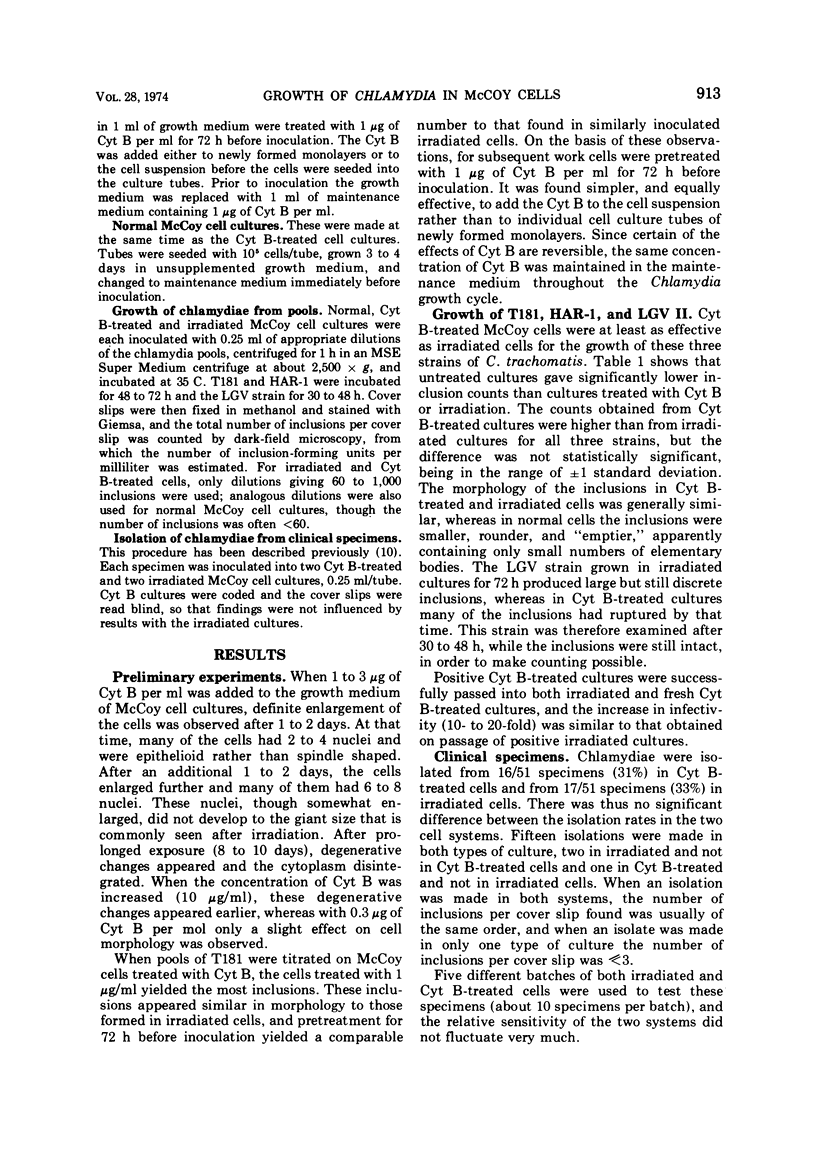Abstract
When the fungal metabolite cytochalasin B was added to McCoy cells, multinucleated giant cells developed. Monolayers of these cells proved as efficient as irradiated cells for the growth of three different serotypes of Chlamydia trachomatis and for the primary isolation of chlamydiae from clinical specimens obtained from patients attending a venereal disease clinic. Cytochalasin treatment of McCoy cells provides a convenient alternative to irradiation and should be of value in the isolation of chlamydiae from the eye and genital tract.
Full text
PDF


Selected References
These references are in PubMed. This may not be the complete list of references from this article.
- Blyth W. A., Taverne J. Cultivation of TRIC agents: a comparison between the use of BHK-21 and irradiated McCoy cells. J Hyg (Lond) 1974 Feb;72(1):121–128. doi: 10.1017/s0022172400023287. [DOI] [PMC free article] [PubMed] [Google Scholar]
- Gordon F. B., Dressler H. R., Quan A. L., McQuilkin W. T., Thomas J. I. Effect of ionizing irradiation on susceptibility of McCoy cell cultures to Chlamydia trachomatis. Appl Microbiol. 1972 Jan;23(1):123–129. doi: 10.1128/am.23.1.123-129.1972. [DOI] [PMC free article] [PubMed] [Google Scholar]
- Gordon F. B., Harper I. A., Quan A. L., Treharne J. D., Dwyer R. S., Garland J. A. Detection of Chlamydia (Bedsonia) in certain infections of man. I. Laboratory procedures: comparison of yolk sac and cell culture for detection and isolation. J Infect Dis. 1969 Oct;120(4):451–462. doi: 10.1093/infdis/120.4.451. [DOI] [PubMed] [Google Scholar]
- Hobson D., Johnson F. W., Rees E., Tait I. A. Simplified method for diagnosis of genital and ocular infections with Chlamydia. Lancet. 1974 Sep 7;2(7880):555–556. doi: 10.1016/s0140-6736(74)91879-0. [DOI] [PubMed] [Google Scholar]
- JONES B. R., COLLIER L. H., SMITH C. H. Isolation of virus from inclusion blennorrhoea. Lancet. 1959 May 2;1(7079):902–905. doi: 10.1016/s0140-6736(59)91307-8. [DOI] [PubMed] [Google Scholar]
- Krishan A. Fine structure of cytochalasin-induced multinucleated cells. J Ultrastruct Res. 1971 Jul;36(1):191–204. doi: 10.1016/s0022-5320(71)80097-7. [DOI] [PubMed] [Google Scholar]
- Kuo C., Wang S., Wentworth B. B., Grayston J. T. Primary isolation of TRIC organisms in HeLa 229 cells treated with DEAE-dextran. J Infect Dis. 1972 Jun;125(6):665–668. doi: 10.1093/infdis/125.6.665. [DOI] [PubMed] [Google Scholar]
- Richmond S. J. The isolation of Chlamydia subgroup A (Chlamydia trachomatis) in irradiated McCoy cells. Med Lab Technol. 1974 Jan;31(1):7–9. [PubMed] [Google Scholar]
- TANG F. F., CHANG H. L., HUANG Y. T., WANG K. C. Studies on the etiology of trachoma with special reference to isolation of the virus in chick embryo. Chin Med J. 1957 Jun;75(6):429–447. [PubMed] [Google Scholar]
- Wang S. P., Grayston J. T. Immunologic relationship between genital TRIC, lymphogranuloma venereum, and related organisms in a new microtiter indirect immunofluorescence test. Am J Ophthalmol. 1970 Sep;70(3):367–374. doi: 10.1016/0002-9394(70)90096-6. [DOI] [PubMed] [Google Scholar]
- Wentworth B. B., Alexander E. R. Isolation of Chlamydia trachomatis by use of 5-iodo-2-deoxyuridine-treated cells. Appl Microbiol. 1974 May;27(5):912–916. doi: 10.1128/am.27.5.912-916.1974. [DOI] [PMC free article] [PubMed] [Google Scholar]


